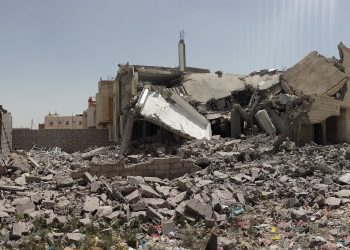Human Lives Human Rights: With utmost care and concentration, Zanyiwe Ncube meticulously poured her portion of precious golden cooking oil into a plastic bottle at a food aid distribution center nestled deep in rural Zimbabwe.
“I can’t afford to waste even a single drop,” she remarked.
Although grateful for the assistance — funded by the United States government in response to the severe drought gripping her southern African nation — Ncube’s relief was tinged with sorrow when aid workers gently announced that this would mark their final visit.
Ncube, accompanied by her 7-month-old son strapped to her back, was among 2,000 individuals who received provisions including cooking oil, sorghum, peas, and other essentials in the Mangwe district of southwestern Zimbabwe.
This distribution initiative is part of a larger program financed by the American aid agency, USAID, and implemented by the United Nations’ World Food Programme, aimed at aiding some of the 2.7 million rural Zimbabweans facing food insecurity due to the prolonged drought that has gripped large swathes of southern Africa since late 2023.
The drought has devastated the crops upon which tens of millions rely for sustenance, compounded by the failure of the anticipated rainy season. Dependence on crops and weather conditions is diminishing rapidly.
The drought’s severity has escalated to crisis levels in Zimbabwe, neighboring Zambia, and Malawi. Both Zambia and Malawi have declared national emergencies, with Zimbabwe poised to follow suit. The drought’s impact has extended to Botswana and Angola in the west, and Mozambique and Madagascar in the east.
A year ago, this region experienced catastrophic tropical storms and floods. It now faces the opposite extreme: a vicious weather cycle characterized by excessive rainfall followed by drought.
This narrative epitomizes the climate extremes increasingly frequent and destructive, particularly for the world’s most vulnerable populations.
In Mangwe, people of all ages queued for assistance, some with donkey carts to transport their provisions home, others with wheelbarrows. Meanwhile, Ncube, 39, would typically be harvesting her crops at this time to feed her two children and a niece under her care, with hopes of surplus for sale.
However, the driest February in Zimbabwe’s recorded history, according to the World Food Programme’s seasonal report, dashed those aspirations. “Our fields are barren; there isn’t a single grain left,” she lamented.
“The drought has decimated everything.” The United Nations Children’s Fund reports “overlapping crises” of extreme weather across eastern and southern Africa, with both regions oscillating between storms and floods and drought and heat over the past year.
In southern Africa, an estimated 9 million people, half of them children, require assistance in Malawi. In Zambia, more than 6 million individuals, including 3 million children, are affected by the drought, constituting nearly half of Malawi’s population and 30% of Zambia’s.
“Alarmingly, extreme weather events are anticipated to become the norm in eastern and southern Africa in the coming years,” remarked Eva Kadilli, UNICEF’s regional director. While climate change has exacerbated global weather volatility, southern Africa is also grappling with another contributing factor this year.
El Niño, the naturally occurring climate phenomenon that periodically warms parts of the Pacific Ocean, has diverse impacts on global weather patterns. In southern Africa, it translates to below-average rainfall, sometimes leading to drought, and is held accountable for the present circumstances.
The repercussions are particularly harsh in Mangwe, renowned for its aridity. Residents cultivate drought-resistant cereal grains like sorghum and pearl millet in hopes of securing harvests, but these crops have succumbed to this year’s harsh conditions.
Francesca Erdelmann, Zimbabwe country director for the World Food Programme, noted that while last year’s harvest was poor, this season’s outlook is even bleaker. “These conditions are anything but normal,” she emphasized.
Traditionally, the first few months of the year are lean times as households await the new harvest. However, prospects for replenishment are dim this year.
Joseph Nleya, a 77-year-old community leader in Mangwe, expressed disbelief at the current heat, dryness, and desperation. “Dams are empty, rivers are dry, and boreholes are scarce. We relied on wild fruits, but even those have dried up,” he observed.
Faced with these dire circumstances, people are resorting to illegal crossings into Botswana in search of sustenance, with hunger driving law-abiding individuals to desperate measures, Nleya added. Multiple aid agencies had warned of an impending catastrophe last year.
Since then, Zambian President Hakainde Hichilema has revealed that 1 million hectares of his country’s staple corn crop have been decimated, while Malawian President Lazarus Chakwera has appealed for $200 million in humanitarian aid.
The 2.7 million rural Zimbabweans struggling to secure sustenance represent just part of the overall picture.
A nationwide crop assessment is underway, with authorities bracing for alarming results that could drastically increase the number requiring assistance, as per Erdelmann of the WFP.
With this year’s harvest essentially lost, millions in Zimbabwe, southern Malawi, Mozambique, and Madagascar will likely face prolonged food insecurity well into 2025. The Famine Early Warning System estimates that 20 million people will require food aid in southern Africa during the initial months of 2024.
Regrettably, many won’t receive this assistance, as aid agencies contend with limited resources amid a global hunger crisis and reductions in humanitarian funding by governments.
As WFP officials concluded their final visit to Mangwe, Ncube began calculating how long the provisions might sustain her. Her greatest fear was that her youngest child would succumb to malnutrition before reaching his first birthday.

















